#kaypro portable computer
Explore tagged Tumblr posts
Text
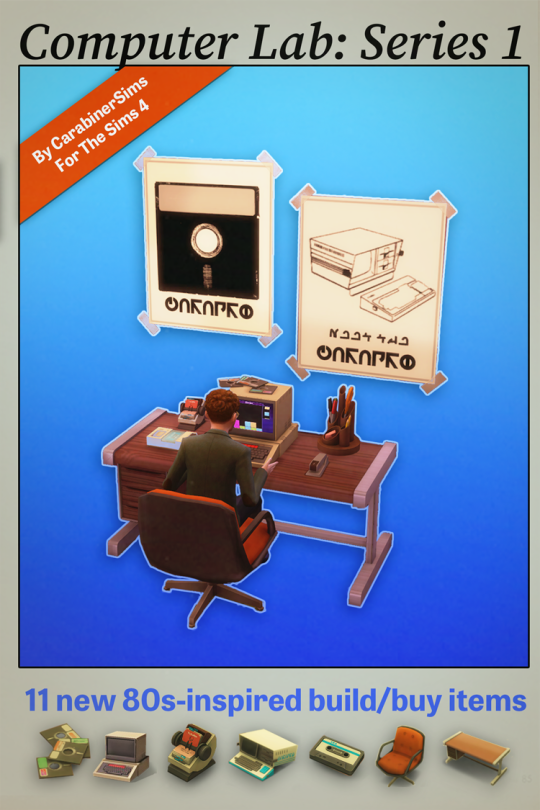
Computer Lab Series 1
This set is inspired by: early 80s computers, my dad’s office when he taught electrical engineering, and VHS tape artifacts. Many of the pieces in here are stylized versions of real-life things, which I’ve included more info about under the cut.
This set contains 11 new meshes and features 2 retro computers, a desk chair, a desk, and lots of retro clutter items.
Download link (SFS): Separate packages or ZIP of the whole thing.
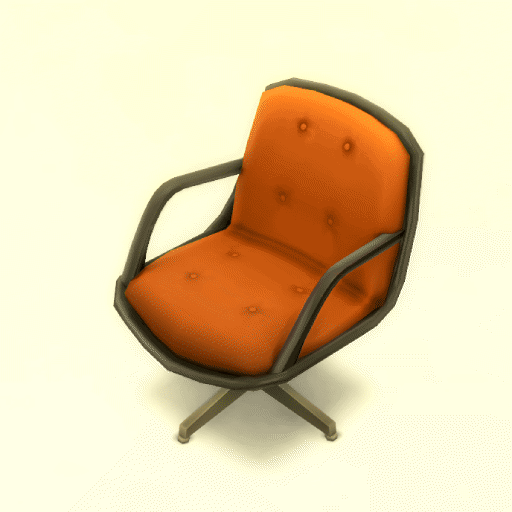

Here's some fancy promo GIFs!
Set contents:
Electronics:
Carapro II Portable Computer: Based on the Kaypro II Portable Computer (1982) // 4 swatches (including wood grain/rainbow!), 789 polys
BBC Micro Computer: Based on the BBC Micro Computer (1981) // 4 swatches (including wood grain/rainbow!), 329 polys
Furniture:
Steelcase Desk Chair // 5 swatches, 746 polys - has 1 LOD
Retro Desk // 4 swatches, 264 polys
Clutter/decor:
Floppy Disks // 2 swatches, 734 polys
Stapler // 3 swatches, 152 polys (has 1 LOD)
Caradex V (Rolodex) // 1 swatch, 834 polys (has 1 LOD)
Desk Caddy // 2 swatches, 1580 polys (has 1 LOD)
Computer Manual Posters // 4 swatches, 20 polys (resized EA soccer poster mesh)
Cassette Recorder // 4 swatches (including wood grain/rainbow!), 212 polys
Cassette Tape // 4 swatches, 202 polys
Here's everything you get:
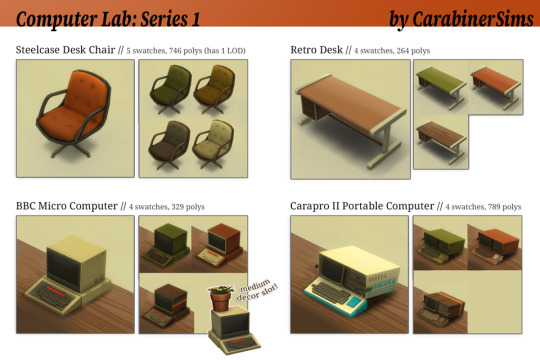
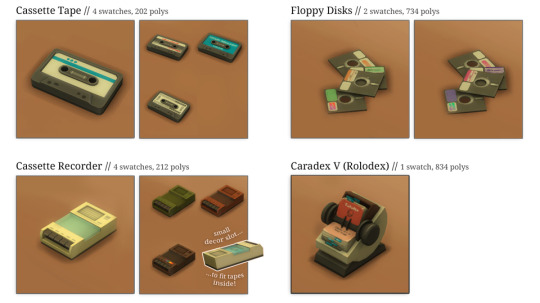
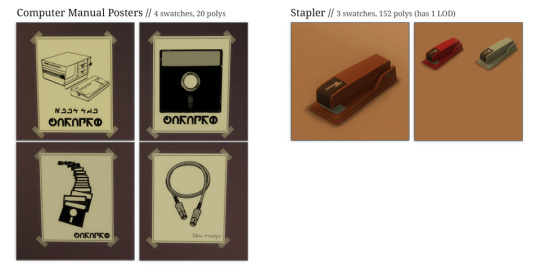
-------------------------------------------------
Credits:
Images for the poster set are taken from the manuals for the Kaypro and BBC Micro; thank you to folks who upload these online!
Fonts used in the textures are Nootrasim, Uni(versity) Llama, and Simlish Crayon.
-------------------------------------------------
Technical notes/known issues:
Sims’ hands slightly clip into the computers with angled keyboards; this is not something I can fix due to how the animations are set up.
The computers don’t have mice (they wouldn’t have had them at the time), so the Sims will move their hands around as if they were using an invisible mouse.
The BBC Micro computer has a medium decor slot on top -- perfect for cute plants, books, clutter, etc. In testing, I noticed that if you place something there that trails down the sides, Sims will not want to use the computer (you have to make them sit in the chair and then interact with it). Most items don’t seem to do this so I’m leaving the slot in - just know if you put trailing stuff on top, this might happen.
The cassette recorder has a decor slot in the perfect place to actually put the cassette tape in it, and I love it! I’d recommend picking the cassette tape you want before putting it in; once it’s in the recorder, I couldn’t figure out an easy way to get it out again. You can always delete the whole thing and re-place a cassette recorder.
-------------------------------------------------
Other notes:
TOU: Don't upload to paid sites or claim you made these. If you do recolor, you can include the mesh if you link back to me.
This is my first larger set and I'm kinda nervous! If you encounter any issues please message me on here and let me know.
I've also created a companion "further reading" post here, which goes into more detail about the research and references I used for these
⭐ Like my stuff? It's all free but it does take me time -- if you want to, feel free to leave a tip on Ko-fi. ⭐
@mmfinds @maxismatchccworld @simbfinds @adoring-ccfinds @mmoutfitters @public-ccfinds
#ts4#ts4mm#ts4mmcc#ts4cc#ts4 cc#retro#kaypro portable computer#kaypro ii portable computer#retrotech#bbc micro#vintage computers#retro computers
2K notes
·
View notes
Text
Our teachers didn’t let us turn on and shut down the computers.
I am, however, this old:

And my computer lab was this era:


#kaypro portable computer#commodor pet#age in computer years#i forget how old i was when i first heard the term ibm#and i remember when#if you had a colour screen in my town#your name was bill gates
12K notes
·
View notes
Text

Kaypro II, Tandy TRS-80 Model 4P, Compaq portable - VCF Southwest 2023
#vcfsw2023#vcf southwest 2023#vintage computer festival southwest 2023#commodorez goes to vcfsw2023#kaypro#compaq portable#tandy 4p
140 notes
·
View notes
Text
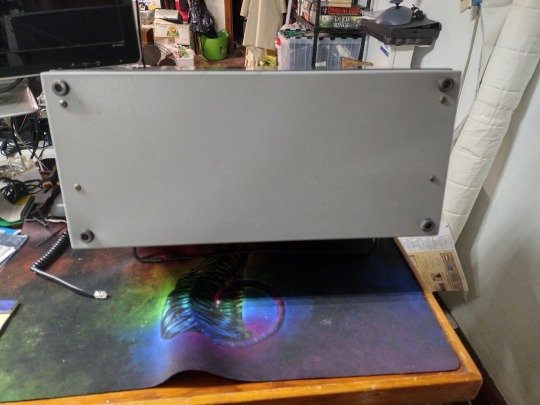
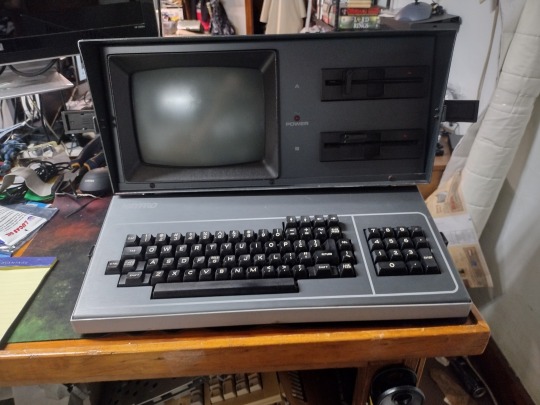
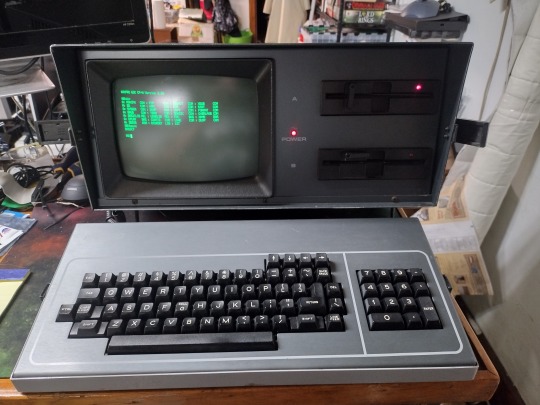

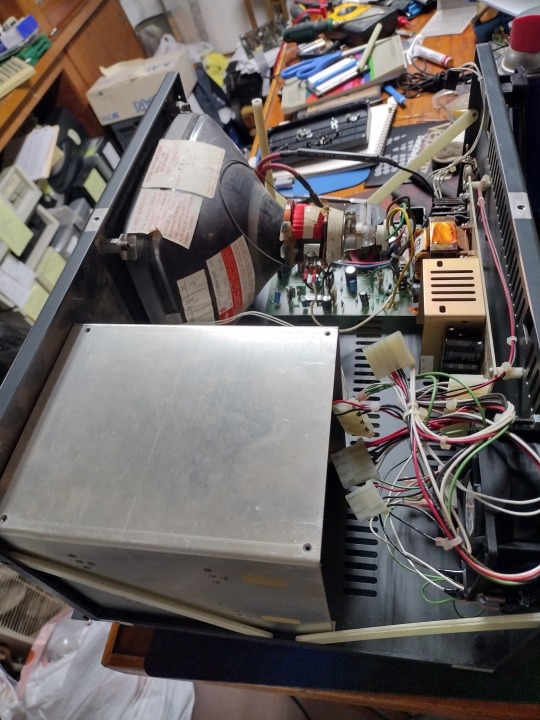
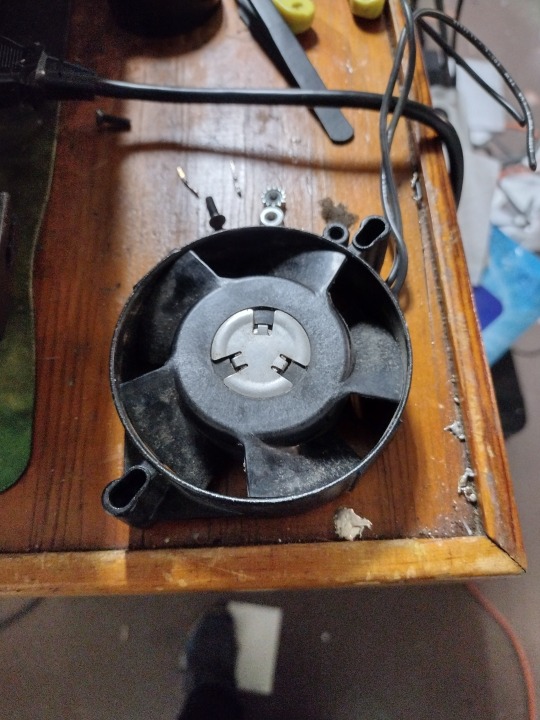
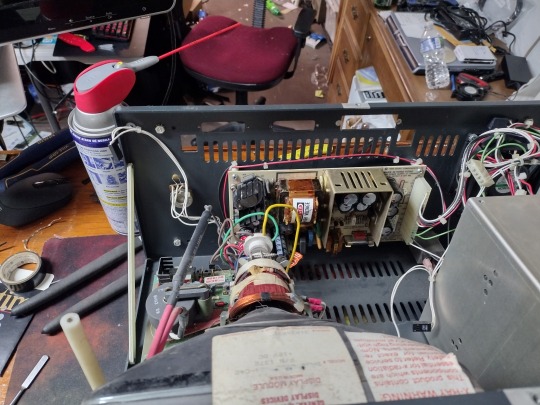

There's a block on my bench... oh wait no, it's a Kaypro. Same difference, just one we tricked a rock into thinking.
Kaypro's are a legendary luggable, that's right than thing was meant to be used on the go. Used is generous term, we'll get back to that. Tough and reliable, these machines found themselves in places that a microcomputer had not been seen before.
In this case for my collection the Kaypro is more than just representing itself, but also representing CP/M machines as a whole, a role that I think it works well in.
CP/M was a once standard OS, much like Windows is now, any company could build a Z80 based computer and license a version of CP/M for it! Once that was done, porting applications was trivial. The OS is extremely simple, the version here for the Kaypro is version 2.2G which is drive aware but has no concept of things like folders (Thats where you store your disks, right?) CP/M precedes MS-DOS (Or more accurately MS DOS is based off CP/M) The basic DOS command for switching disks and displaying a disk directory are identical. Launching a program is just as easy as typing it's name into the command prompt.
For a microcomputer, this system was more aimed at productivity, wordprocessing, spreadsheets and databases were all common applications for CP/M machines although games and BASIC could be found as well as other languages of the day.
Now I mentioned it's a luggable, which is to say, the system closed up could be moved around. It does not have any internal batteries and must be plugged in to run, on top of that this machine is not light, coming in around 40 lbs (19kg)!
25 notes
·
View notes
Text


Kaypro 4/84
90 notes
·
View notes
Text
Just 40 years ago top of the art. Now something of the past. Time goes so fast. 4 more years will go by like seconds. Don't worry be happy!
The Zorba was a portable computer running the CP/M operating system manufactured in 1983 and 1984. It was originally manufactured by Telcon Industries, Inc., of Fort Lauderdale, Florida, a company specialized in telecommunication equipment manufacturing.
The Zorba was one of the last CP/M computers on the market. By the time it was introduced, the Kaypro and Osborne machines already dominated that market. The introduction of the Compaq Portable, compatible with the IBM PC and running MS-DOS, sealed the fate of the CP/M machines.

3K notes
·
View notes
Text

Another 2022-present portable computer thing. This is a 1991 Corvallis Microtechnologies PC5-L. It's a ruggedized, waterproof handheld MS-DOS computer meant for industrial applications. It ran on Ni-Cd batteries and they died so now it runs on AA's I got two of them for $50 on eBay during one of those months when i impulse buy obscure electronics as a form of escapism This thing is an absolute brick. You could murder someone by hitting them on the head with this, and it would work fine afterwards. Here's pictures of its organs for anyone curious:




That thick red wire around the screen PCB is a heater. Yep there's a setting to heat up the LCD so it doesn't get sluggish or shatter when you decide to leave it in the freezer. The thing runs on a little system-on-chip thing, which is interesting to see coming from the early 90's. Iirc the datasheet says it's capable of analog video out as well as driving the LCD, but I haven't poked around enough to enable it. Might be cool to hook it up to a TV. I did, however, open those 512k storage modules and I saw some unpopulated footprints on the boards. So I ordered some of the same chips, and at some point I'mma try soldering them on and see if it recognizes the extra space. They came with two voltmeter modules, which I couldn't get to work, so I took one of the casings and made it into a USB and WiFi adapter using an ESP32 running Zimodem, since this thing has RS232 ports on the top. I also made my own charging adapter, since they didn't come with one. I see that internal PCMCIA slot, and I tried putting a CF card adapter in, and tried installing the drivers, but it didn't work. I'm not good at DOS tbh, and I know nothing of what this slot is for. I might come back to it later. I did all of this in 2022-23 and haven't messed with it since. Except to use it to talk to my Kaypro 4 '84:

More on that one later. I love portable computers !!!!!
1 note
·
View note
Photo

Lawrence Tesler, Who Made Personal Computing Easier, Dies at 74
Lawrence Tesler, a pioneering computer scientist who helped make it easier for users to interact with computers, whether cutting and pasting text or selecting text by dragging a cursor through it, died on Sunday at his home in Portola Valley, Calif. He was 74.
The cause was not known, his wife, Colleen Barton, said, but in recent years he had suffered the effects of an earlier bicycle accident.
Mr. Tesler worked at a number of Silicon Valley’s most important companies, including Apple under Steve Jobs. But it was as a young researcher for Xerox at its Palo Alto Research Center in the 1970s that he did his most significant work: helping to develop today’s style of computer interaction based on a graphical desktop metaphor and a mouse.
Early in his Xerox career (he began there in 1973), Mr. Tesler and another researcher, Tim Mott, developed a program known as Gypsy, which did away with the restrictive modes that had made text editing complicated. For example, until Gypsy, most text-editing software had one mode for entering text and another for editing it.
Mr. Tesler was passionate about simplifying interaction with computers. At Apple he was responsible for the idea that a computer mouse should have only one button. For many years the license plate on his car read, “NO MODES.”
His first breakthrough at Xerox PARC came when he took a newly hired secretary, sat her in front of a blank computer monitor and took notes while she described how she would prefer to compose documents with a computer. She proceeded to describe a very simple system, which Mr. Tesler then implemented with Mr. Mott.
The Gypsy program offered such innovations as the “cut and paste” analogy for moving blocks of text and the ability to select text by dragging the cursor through it while holding down a mouse button. It also shared with an earlier Xerox editor, Bravo, what became known as “what you see is what you get” printing (or WYSIWYG), a phrase Mr. Tesler used to describe a computer display that mirrored printed output.
And Gypsy brought to fruition the idea of opening a computer file by simply clicking on a screen icon while pointing at it with the mouse cursor. Before that, files had to be opened by typing the file name into a command line.
“At Xerox he pushed a lot for things to be simpler in ways that would broaden the base of users,” said David Liddle, a veteran Silicon Valley venture capitalist who worked with Mr. Tesler at Xerox PARC. “He was always quite focused on users who weren’t also Ph.D.s in computer science.”
Mr. Tesler later joined a small team of researchers run by Alan Kay, a visionary computer scientist who had pioneered the idea of a so-called Dynabook, which would become the inspiration for today’s laptop computers. The group was developing a software environment called Smalltalk, and Mr. Tesler developed a system for searching for software components, which he named the browser.
“He can be hailed as one of the true pioneers of many important aspects of personal computing,” Mr. Kay said.
After attending a demonstration of the Altair, an early hobbyist personal computer, at a Palo Alto hotel in 1975, Mr. Tesler returned to PARC to alert his colleagues to the arrival of low-cost systems. His warnings were largely ignored.
He continued to press for less costly computers. In 1978, with Adele Goldberg and Douglas Fairbairn, he designed a portable machine called NoteTaker, a forerunner of luggable computers like the Osborne, Kaypro and Compaq machines of the early 1980s. But Xerox declined to commercialize the NoteTaker; only a few prototypes were made.
It was Mr. Tesler who gave Mr. Jobs the celebrated demonstration of the Xerox Alto computer and the Smalltalk software system that would come to influence the design of Apple’s Lisa personal computer and then its Macintosh.
Mr. Tesler left Xerox to work for Mr. Jobs at Apple in 1980.
“The questions the Apple people were asking totally blew me away,” Mr. Tesler was quoted as saying in a profile that appeared in IEEE Spectrum, the magazine of the Institute of Electrical and Electronics Engineers, in 2005. “They were the kind of questions Xerox executives should have been asking but didn’t.”
In addition to helping develop the Lisa and Macintosh, Mr. Tesler founded and ran Apple’s Advanced Technology Group, after which he led the design of the Newton handheld computer, although that proved unsuccessful. The group also created much of the technology that would become the Wi-Fi wireless standard, and Mr. Tesler led an Apple joint venture with two other companies that created Acorn RISC Machine, a partnership intended to provide a microprocessor for the Newton.
Although Apple eventually sold off its holdings in that venture, it would come to dominate the market for the chips that power today’s smartphones. The chip architecture created by the partnership is today the most widely used microprocessor design in the world.
Mr. Tesler left Apple in 1997 for a startup and later went on to work for both Amazon and Yahoo. He left Yahoo in 2008 and spent a year as a product fellow at 23andMe, the genetics information company. He was most recently an independent consultant.
Lawrence Gordon Tesler was born in the Bronx on April 24, 1945, to Isidore and Muriel (Krechman) Tesler. His father was an anesthesiologist.
In 1960, while attending the Bronx High School of Science, Mr. Tesler developed a new method of generating prime numbers. He showed it to one of his teachers, who was impressed. As Mr. Tesler later recalled, he told the teacher that the method was a formula; the teacher responded, “No, it’s not really a formula, it’s an algorithm, and it can be implemented on a computer.”
“Where do you find a computer?” Mr. Tesler asked.
The teacher said he would first get him a programming manual and then figure out where to find a computer.
One day Mr. Tesler was sitting in the school cafeteria reading his manual, which offered instructions on how to program an IBM 650 mainframe in the most low-level, arcane machine programming language.
A student walked up to Mr. Tesler and asked, “What are you doing with that?”
“I’m learning about programming,” Mr. Tesler responded.
The other student alerted Mr. Tesler to a program at Columbia University, which gave high school students programming time. He was able to use a university computer for a half-hour each week, teaching himself to program before he got to college.
He attended Stanford, graduating in 1965 with a degree in mathematics. While there, he became involved in a number of early projects that prefigured personal computing.
Mr. Tesler had early access to a computer known as a LINC when he worked as a student programmer for the Nobel laureate Joshua Lederberg. The LINC, designed by the M.I.T. physicist Wesley A. Clark, is believed by many computer historians to have been the first true personal computer.
Mr. Tesler’s first start-up venture was a programming consulting company located in a shopping mall next to the Stanford campus. He also used a mainframe computer to build a system to permit the student rooting section at Stanford football games to program elaborate card stunts. It was, Mr. Kay said, a forerunner to the ways in which modern graphical displays would be programmed.
In 1969, with two other scientists at the Stanford Artificial Intelligence Laboratory, Mr. Tesler created a design for a small computer and proposed it to the calculator company Friden. Although intrigued, the company declined to pursue the idea.
Mr. Tesler left computing for a short while after that and moved to an Oregon commune with his daughter from a short-lived marriage. Lack of work led him back to the Bay Area, where he would join Xerox PARC.
In addition to Ms. Barton, a geophysicist, and his daughter, Lisa Tesler, he is survived by two brothers, Charles and Alan.
At Stanford and afterward, Mr. Tesler was active in both the antiwar movement and the 1960s counterculture. He participated in an alternative school, the Midpeninsula Free University, where he taught classes, including one exclusively for people born under the sign of Taurus. In 1968 he taught a class titled “How to End the IBM Monopoly.”
Years later, as a computer scientist at Xerox, he remembered his activist roots, his former colleague Ms. Goldberg said. The Central Intelligence Agency was a Xerox customer, and when agency employees arrived for a meeting, Mr. Tesler attended wearing a trench coat and a fedora.
When you’re cutting and pasting, dragging the cursor over selected text and performing other common computer tasks, you can thank him.
Daily inspiration. Discover more photos at http://justforbooks.tumblr.com
17 notes
·
View notes
Text
My first computer was a KayPro II - what was yours?
My first computer was a KayPro II – what was yours?
The year was 1983 when I simultaneously bought a “state-of-the-art” KayPro II “portable” computer and enrolled in a Computer Science class at the University of Southern California. The class was required to earn a B.S. degree in Business Administration and I thought the computer would give me the edge, although I had no clue on how to use it. The KayPro II computer was created by San Diego…

View On WordPress
1 note
·
View note
Text
Lawrence Tesler, Pioneer of Personal Computing, Dies at 74
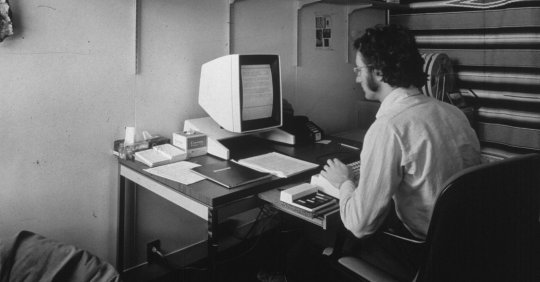
Lawrence Tesler, a pioneering computer scientist who, in his work at Xerox and with Steve Jobs at Apple, devoted himself to making it easier for users to interact with computers, died on Sunday at his home in Portola Valley, Calif. He was 74.The cause was not known, his wife, Colleen Barton, said. the cause was not known. But at in recent years Mr. Tesler had suffered the effects of an earlier bicycle accident.During his career Mr. Tesler worked at a number of Silicon Valley’s most important companies. But it was as a young researcher at Xerox’s Palo Alto Research Center in the 1970s that he did his most significant work, helping to develop today’s style of computer interaction based on a graphical desktop metaphor and a mouse.Early in his Xerox career (he began there in 1973), working with another researcher, Tim Mott, Mr. Tesler developed a program known as Gypsy, which did away with the restrictive modes that had made text editing complicated. For example, until Gypsy, most text-editing software had one mode for entering text and another for editing it.Mr. Tesler was passionate about simplifying interaction with computers. At Apple he was responsible for the idea that a computer mouse should have only one button. For many years the license plate on his car read, “NO MODES.”At Xerox PARC, his first breakthrough came when he took a newly hired secretary, sat her in front of a blank computer monitor and took notes while she described how she would prefer to compose documents with a computer. She proceeded to describe a very simple system, which Mr. Tesler then implemented with Mr. Mott.The Gypsy program contained such innovations as the “cut and paste” analogy for moving blocks of text and the ability to select text by dragging the cursor through it while holding down a mouse button. It also shared with an earlier Xerox editor, Bravo, what became known as “what you see is what you get” or WYSIWYG printing, a phrase Mr. Tesler used to describe a computer display that mirrored printed output.And it implemented the idea of opening a computer file by simply clicking on a screen icon while pointing at it with the mouse cursor. Before that, files had to be opened by typing the file name into a command line.“At Xerox he pushed a lot for things to be simpler in ways that would broaden the base of users,” said David Liddle, a veteran Silicon Valley venture capitalist who worked with Mr. Tesler at Xerox PARC. “He was always quite focused on users who weren’t also Ph.D.s in computer science.”Mr. Tesler later joined a small team of researchers run by Alan Kay, a visionary computer scientist who had pioneered the idea of a so-called Dynabook, which would become the inspiration for today’s laptop computers. The group was developing a software environment called Smalltalk, and Mr. Tesler developed a system for searching for software components, which he named the browser.“He can be hailed as one of the true pioneers of many important aspects of personal computing,” Mr. Kay said.After attending a demonstration of the Altair, an early hobbyist personal computer, at a Palo Alto hotel in 1975, Mr. Tesler returned to PARC to alert his colleagues to the arrival of low-cost systems. His warnings were largely ignored.He continued to advocate for less costly computers. In 1978, with Adele Goldberg and Douglas Fairbairn, he designed a portable machine called NoteTaker, a forerunner of luggable computers like the Osborne, Kaypro and Compaq machines of the early 1980s. But Xerox declined to commercialize the NoteTaker; only a few prototypes were made.It was Mr. Tesler who gave Steve Jobs the celebrated demonstration of the Xerox Alto computer and the Smalltalk software system that would come to influence the design of first Apple’s Lisa personal computer and then its Macintosh.Mr. Tesler left Xerox to work for Mr. Jobs at Apple in 1980.“The questions the Apple people were asking totally blew me away,” Mr. Tesler was quoted as saying in a profile that appeared in IEEE Spectrum, the magazine of the Institute of Electrical and Electronics Engineers, in 2005. “They were the kind of questions Xerox executives should have been asking but didn’t.”In addition to helping develop the Lisa and Macintosh, Mr. Tesler founded and ran the company’s Advanced Technology Group, where he led the design of the Newton hand-held computer, although that proved unsuccessful. The Advanced Technology Group also created much of the technology that would become the Wi-Fi wireless standard, and Mr. Tesler led an Apple joint venture with two other companies that created Acorn RISC Machine, a partnership intended to provide a microprocessor for the Newton.Although Apple would eventually sell off its holdings in that company, it would come to dominate the market for the chips that power today’s smartphones. The chip architecture created by the partnership is today the most widely used microprocessor design in the world.Mr. Tesler left Apple in 1997 for a start-up and later went on to work for both Amazon and Yahoo. He left Yahoo in 2008 and spent a year as a product fellow at 23andMe, the genetics information company. He was most recently an independent consultant.Lawrence Gordon Tesler was born in the Bronx on April 24, 1945, to Isidore and Muriel (Krechman) Tesler. His father was an anesthesiologist.In 1960, while attending the Bronx High School of Science, Mr. Tesler developed a new method of generating prime numbers. He showed it to one of his teachers, who was impressed. As Mr. Tesler later recalled, he told the teacher it was a formula; the teacher responded, “No, it’s not really a formula, it’s an algorithm, and it can be implemented on a computer.”“Where do you find a computer?” Mr. Tesler asked.The teacher said he would get him a programming manual first and then figure out where to find a computer.One day Mr. Tesler was sitting in the school cafeteria reading his manual, which offered instructions on how to program an IBM 650 mainframe in the most low-level, arcane machine programming language.A student walked up to Mr. Tesler and asked, “What are you doing with that?”“I’m learning about programming,” Mr. Tesler responded.The other student alerted Mr. Tesler to a program at Columbia University, which gave high school students programming time. He was able to use a university computer for a half-hour each week, teaching himself to program before he got to college.He attended Stanford, graduating in 1965 with a degree in mathematics. While there, he became involved in a number of early projects that prefigured personal computing. He had early access to a computer known as a LINC when he worked as a student programmer for the Nobel laureate Joshua Lederberg. The LINC, designed by the M.I.T. physicist Wesley A. Clark, is believed by many computer historians to have been the first true personal computer.Mr. Tesler’s first start-up venture was a programming consulting company located in a mall adjacent to the Stanford campus. He also used a mainframe computer to build a system to permit the Stanford football student rooting section to program elaborate card stunts. It was, Mr. Kay said, a forerunner to the ways in which modern graphical displays would be programmed.In 1969, with two other scientists at the Stanford Artificial Intelligence Laboratory, Mr. Tesler designed a small computer and proposed the idea to the calculator company Frieden. Although intrigued, the company declined to pursue the idea.Mr. Tesler left computing for a short while after that and moved to an Oregon commune with his daughter from a short-lived marriage. Lack of work led him back to the Bay Area, where he would eventually join Xerox PARC.In addition to Ms. Barton, a geophysicist, and his daughter, Lisa Tesler, he is survived by two brothers, Charles and Alan.At Stanford and afterward, Mr. Tesler was active in both the antiwar movement and the 1960s counterculture. He was a participant in an alternative school formed around Stanford, the Mid-Peninsula Free University, where he taught several classes, including one exclusively for people born under the sign of Taurus. In 1968 he taught a class titled “How to End the IBM Monopoly.”Years later, as a computer scientist at Xerox, his former colleague Ms. Goldberg said, he remembered his activist roots. The Central Intelligence Agency was a Xerox customer, and when agency employees arrived for a meeting, Mr. Tesler attended wearing a trench coat and a fedora. Read the full article
#0financetechnology#0technologydrive#03technologysolutions#057technology#0dbtechnology#0gtechnology#1/0technologycorp#2000stechnology#3technologybetsgenpact#3technologydrive#3technologydrivepeabodyma#3technologydrivewestboroughmassachusetts01581#3technologywaynorwoodma#3dprintingtechnews#3dtechnews#3dtechnologynews#4technologycircuithallam#4technologydr#4technologydrive#4technologydrivepeabodyma01960#4technologydrivewestboroughma#42technologynews#5technologydriveirvineca#5technologydrivemilfordma#5technologydrivewallingfordct#5technologymission#5technologyoneliners#5technologyparkcolindeeplane#5technologytools#5technologytrends
0 notes
Text
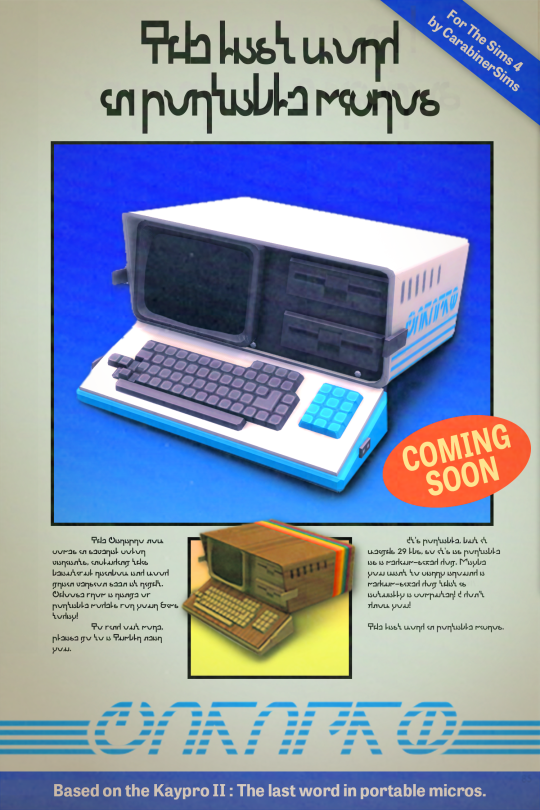
The Carapro II: coming soon to a Sims 4 Mods folder near you. (Announcement image based on this ad)
#ts4cc#s4cc#ts4mmcc#s4mmcc#sims 4#ts4#download#hardware#retrotech#kaypro portable computer#kaypro#kaypro ii#retro computer
205 notes
·
View notes
Text
Lawrence Tesler, Pioneer of Personal Computing, Dies at 74
Lawrence Tesler, a pioneering computer scientist who, in his work at Xerox and with Steve Jobs at Apple, devoted himself to making it easier for users to interact with computers, died on Sunday at his home in Portola Valley, Calif. He was 74.
The cause was not known, his wife, Colleen Barton, said. the cause was not known. But at in recent years Mr. Tesler had suffered the effects of an earlier bicycle accident.
During his career Mr. Tesler worked at a number of Silicon Valley’s most important companies. But it was as a young researcher at Xerox’s Palo Alto Research Center in the 1970s that he did his most significant work, helping to develop today’s style of computer interaction based on a graphical desktop metaphor and a mouse.
Early in his Xerox career (he began there in 1973), working with another researcher, Tim Mott, Mr. Tesler developed a program known as Gypsy, which did away with the restrictive modes that had made text editing complicated. For example, until Gypsy, most text-editing software had one mode for entering text and another for editing it.
Mr. Tesler was passionate about simplifying interaction with computers. At Apple he was responsible for the idea that a computer mouse should have only one button. For many years the license plate on his car read, “NO MODES.”
At Xerox PARC, his first breakthrough came when he took a newly hired secretary, sat her in front of a blank computer monitor and took notes while she described how she would prefer to compose documents with a computer. She proceeded to describe a very simple system, which Mr. Tesler then implemented with Mr. Mott.
The Gypsy program contained such innovations as the “cut and paste” analogy for moving blocks of text and the ability to select text by dragging the cursor through it while holding down a mouse button. It also shared with an earlier Xerox editor, Bravo, what became known as “what you see is what you get” or WYSIWYG printing, a phrase Mr. Tesler used to describe a computer display that mirrored printed output.
And it implemented the idea of opening a computer file by simply clicking on a screen icon while pointing at it with the mouse cursor. Before that, files had to be opened by typing the file name into a command line.
“At Xerox he pushed a lot for things to be simpler in ways that would broaden the base of users,” said David Liddle, a veteran Silicon Valley venture capitalist who worked with Mr. Tesler at Xerox PARC. “He was always quite focused on users who weren’t also Ph.D.s in computer science.”
Mr. Tesler later joined a small team of researchers run by Alan Kay, a visionary computer scientist who had pioneered the idea of a so-called Dynabook, which would become the inspiration for today’s laptop computers. The group was developing a software environment called Smalltalk, and Mr. Tesler developed a system for searching for software components, which he named the browser.
“He can be hailed as one of the true pioneers of many important aspects of personal computing,” Mr. Kay said.
After attending a demonstration of the Altair, an early hobbyist personal computer, at a Palo Alto hotel in 1975, Mr. Tesler returned to PARC to alert his colleagues to the arrival of low-cost systems. His warnings were largely ignored.
He continued to advocate for less costly computers. In 1978, with Adele Goldberg and Douglas Fairbairn, he designed a portable machine called NoteTaker, a forerunner of luggable computers like the Osborne, Kaypro and Compaq machines of the early 1980s. But Xerox declined to commercialize the NoteTaker; only a few prototypes were made.
It was Mr. Tesler who gave Steve Jobs the celebrated demonstration of the Xerox Alto computer and the Smalltalk software system that would come to influence the design of first Apple’s Lisa personal computer and then its Macintosh.
Mr. Tesler left Xerox to work for Mr. Jobs at Apple in 1980.
“The questions the Apple people were asking totally blew me away,” Mr. Tesler was quoted as saying in a profile that appeared in IEEE Spectrum, the magazine of the Institute of Electrical and Electronics Engineers, in 2005. “They were the kind of questions Xerox executives should have been asking but didn’t.”
In addition to helping develop the Lisa and Macintosh, Mr. Tesler founded and ran the company’s Advanced Technology Group, where he led the design of the Newton hand-held computer, although that proved unsuccessful. The Advanced Technology Group also created much of the technology that would become the Wi-Fi wireless standard, and Mr. Tesler led an Apple joint venture with two other companies that created Acorn RISC Machine, a partnership intended to provide a microprocessor for the Newton.
Although Apple would eventually sell off its holdings in that company, it would come to dominate the market for the chips that power today’s smartphones. The chip architecture created by the partnership is today the most widely used microprocessor design in the world.
Mr. Tesler left Apple in 1997 for a start-up and later went on to work for both Amazon and Yahoo. He left Yahoo in 2008 and spent a year as a product fellow at 23andMe, the genetics information company. He was most recently an independent consultant.
Lawrence Gordon Tesler was born in the Bronx on April 24, 1945, to Isidore and Muriel (Krechman) Tesler. His father was an anesthesiologist.
In 1960, while attending the Bronx High School of Science, Mr. Tesler developed a new method of generating prime numbers. He showed it to one of his teachers, who was impressed. As Mr. Tesler later recalled, he told the teacher it was a formula; the teacher responded, “No, it’s not really a formula, it’s an algorithm, and it can be implemented on a computer.”
“Where do you find a computer?” Mr. Tesler asked.
The teacher said he would get him a programming manual first and then figure out where to find a computer.
One day Mr. Tesler was sitting in the school cafeteria reading his manual, which offered instructions on how to program an IBM 650 mainframe in the most low-level, arcane machine programming language.
A student walked up to Mr. Tesler and asked, “What are you doing with that?”
“I’m learning about programming,” Mr. Tesler responded.
The other student alerted Mr. Tesler to a program at Columbia University, which gave high school students programming time. He was able to use a university computer for a half-hour each week, teaching himself to program before he got to college.
He attended Stanford, graduating in 1965 with a degree in mathematics. While there, he became involved in a number of early projects that prefigured personal computing.
He had early access to a computer known as a LINC when he worked as a student programmer for the Nobel laureate Joshua Lederberg. The LINC, designed by the M.I.T. physicist Wesley A. Clark, is believed by many computer historians to have been the first true personal computer.
Mr. Tesler’s first start-up venture was a programming consulting company located in a mall adjacent to the Stanford campus. He also used a mainframe computer to build a system to permit the Stanford football student rooting section to program elaborate card stunts. It was, Mr. Kay said, a forerunner to the ways in which modern graphical displays would be programmed.
In 1969, with two other scientists at the Stanford Artificial Intelligence Laboratory, Mr. Tesler designed a small computer and proposed the idea to the calculator company Frieden. Although intrigued, the company declined to pursue the idea.
Mr. Tesler left computing for a short while after that and moved to an Oregon commune with his daughter from a short-lived marriage. Lack of work led him back to the Bay Area, where he would eventually join Xerox PARC.
In addition to Ms. Barton, a geophysicist, and his daughter, Lisa Tesler, he is survived by two brothers, Charles and Alan.
At Stanford and afterward, Mr. Tesler was active in both the antiwar movement and the 1960s counterculture. He was a participant in an alternative school formed around Stanford, the Mid-Peninsula Free University, where he taught several classes, including one exclusively for people born under the sign of Taurus. In 1968 he taught a class titled “How to End the IBM Monopoly.”
Years later, as a computer scientist at Xerox, his former colleague Ms. Goldberg said, he remembered his activist roots. The Central Intelligence Agency was a Xerox customer, and when agency employees arrived for a meeting, Mr. Tesler attended wearing a trench coat and a fedora.
from WordPress https://mastcomm.com/tech/lawrence-tesler-pioneer-of-personal-computing-dies-at-74/
0 notes
Note
What kind of work can be done on a commodore 64 or those other old computers? The tech back then was extremely limited but I keep seeing portable IBMs and such for office guys.
I asked a handful of friends for good examples, and while this isn't an exhaustive list, it should give you a taste.
I'll lean into the Commodore 64 as a baseline for what era to hone in one, let's take a look at 1982 +/-5 years.
A C64 can do home finances, spreadsheets, word processing, some math programming, and all sorts of other other basic productivity work. Games were the big thing you bought a C64 for, but we're not talking about games here -- we're talking about work. I bought one that someone used to write and maintain a local user group newsletter on both a C64C and C128D for years, printing labels and letters with their own home equipment, mailing floppies full of software around, that sorta thing.
IBM PCs eventually became capable of handling computer aided design (CAD) work, along with a bunch of other standard productivity software. The famous AutoCAD was mostly used on this platform, but it began life on S-100 based systems from the 1970s.
Spreadsheets were a really big deal for some platforms. Visicalc was the killer app that the Apple II can credit its initial success with. Many other platforms had clones of Visicalc (and eventually ports) because it was groundbreaking to do that sort of list-based mathematical work so quickly, and so error-free. I can't forget to mention Lotus 1-2-3 on the IBM PC compatibles, a staple of offices for a long time before Microsoft Office dominance.
CP/M machines like Kaypro luggables were an inexpensive way of making a "portable" productivity box, handling some of the lighter tasks mentioned above (as they had no graphics functionality).
The TRS-80 Model 100 was able to do alot of computing (mostly word processing) on nothing but a few AA batteries. They were a staple of field correspondence for newspaper journalists because they had an integrated modem. They're little slabs of computer, but they're awesomely portable, and great for writing on the go. Everyone you hear going nuts over cyberdecks gets that because of the Model 100.
Centurion minicomputers were mostly doing finances and general ledger work for oil companies out of Texas, but were used for all sorts of other comparable work. They were multi-user systems, running several terminals and atleast one printer on one central database. These were not high-performance machines, but entire offices were built around them.
Tandy, Panasonic, Sharp, and other brands of pocket computers were used for things like portable math, credit, loan, etc. calculation for car dealerships. Aircraft calculations, replacing slide rules were one other application available on cassette. These went beyond what a standard pocket calculator could do without a whole lot of extra work.
Even something like the IBM 5340 with an incredibly limited amount of RAM but it could handle tracking a general ledger, accounts receivable, inventory management, storing service orders for your company. Small bank branches uses them because they had peripherals that could handle automatic reading of the magnetic ink used on checks. Boring stuff, but important stuff.
I haven't even mentioned Digital Equipment Corporation, Data General, or a dozen other manufacturers.
I'm curious which portable IBM you were referring to initially.
All of these examples are limited by today's standards, but these were considered standard or even top of the line machines at the time. If you write software to take advantage of the hardware you have, however limited, you can do a surprising amount of work on a computer of that era.
43 notes
·
View notes
Text
O Seu Ducto De Cursos Acessível
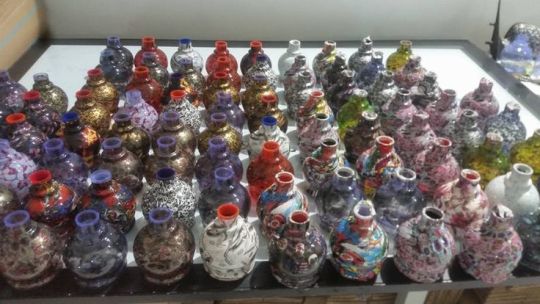
Caso você esteja interessao em conhecer sobre um óptimo curso de Pintura Hidrográfica WTP, você está no lugar correto. It was developed at Beam Aplicativo by Philip Mitchell and Veronika Megler and published by Melbourne House for most home computers available at the time, from more popular models such as the ZX Spectrum, the Commodore 64, Amstrad CPC 464, BBC Micro, MSX, Dragon 32 and Oric. Videos and presentations, along with supporting materials, from the annual Personal Digital Archiving conferences held at various institutions since 2010. I realize that you're not the sole person to make this decision but I'm asking you today for your commitment to advocate to finding a way to find desaparece limited information to become public so we could have a real discussão about this.
https://wtplegal92.newsvine.com/_news/2017/09/13/38352282-uol-mas-quanto-cobrar-pelo-servio-de-pintura-hidrogrficaveja?&statusCode=success&statusMessage=Your+request+has+been+successfully+processed The Royal Ontario Museum is among the world's leading museums of oriundo history, and of world cultures. The film centers conectado the life of Tod Lubitch (John Travolta), who was born with an improperly functioning immune system. Também tem interesse de ter uma usina nuclear a Bahia e também Sergipe. Collections include the unique contemporary compositions and performances found in the Other Minds collection, the hundreds of popular songs from the early 20th Century found in the 78 RPM collection and oral history projects. Tales of the Texas Rangers, a western adventure old-time radio drama, premiered conectado July 8, 1950, conectado the US NBC radio network and remained conectado the air through September 14, 1952. The novato is full of sarcasm and dark humour, even as it treats its serious subject, revealing the hypocrisies of the time. In this collection, first published in 1905, the great detective causes Watson to faint (The Empty House), demonstrates that cryptography is elementary (The Dancing Men), and gets engaged (Charles Augustus Milverton). Monte Seu Próprio Negócio de Sensação Hidrográfica. The posted time is from the final save time, shown at the end (3:35) with 11 minutes added for the 10.5 minutes of play time from then until finishing the game. Do programa, consta uma reunião com a AHETA e outra com IPSS do Algarve, também um almoço com presidentes de Câmara, vereadores e também presidentes de troço do partido na área. This is part of the larger TV News Archive The project explored the public interest values of a digital library of 2014 political tevê advertising, centered in the Philadelphia metro region. Temos uma Bienal do mercosul, um atuante Instituto de Artes, há pouco foi inaugurado a Fundação Iberê Camargo e também, aliás, temos reunião de Artes Plásticas do Rio Extensa do Sul. Understanding how and why the coverage took shape as it did yields new insights into the social, científico and political consequences of the attacks, while also highlighting the role of news media in the creation, affirmation and dissemination of meanings in modern life.

https://www.diigo.com/profile/nesmeroshow70 Epic history of industrial medicine in the first half of the 20th century, showing how manufacturers and the medical profession came to terms with one another and culminating in GM's rehabilitation program for returned World War II veterans. Segundo Canen (2001), Gandin (1995) e Luckesi (1996), a avaliação é um julgamento sobre uma verdade concreta ou sobre uma prática, à luz de padrões claros, estabelecidos prévia ou concomitantemente, para tomada de resolução. Kaypro produced a line of rugged, portable CP/M-based computers sold with an extensive utilitário bundle which supplanted its competitors and quickly became one of the top selling personal computer lines of the early 1980s. A partir de dia 11 de outubro, as operadoras de telecomunicação começaram a instruir os usuários a incluir número nove primeiro dos oitos dígitos tradicionais em Sergipe.
0 notes
Text
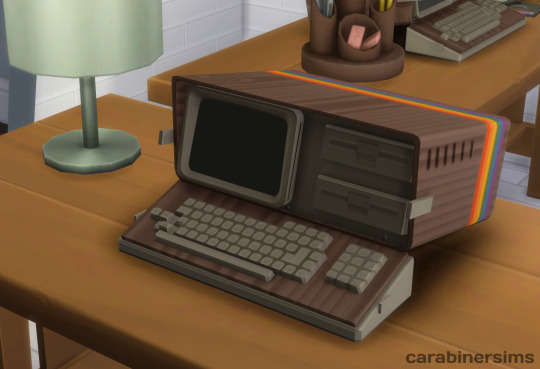
Coming soon-ish.
The Carapro Portable Computer is... technically portable, but it weighs 29 lbs, so it's as portable as a medium-sized dog. Maybe you want to carry around a medium-sized dog that is actually a computer! I don't know you! // by CarabinerSims
Notes: Based on the Kaypro Portable Computer. I know this more 70s wood paneling colorway isn't historically accurate but... it looks tiiiight and this is a video game.
#ts4#ts4 cc#ts4mm#ts4 cc creator#ts4 bb#ts4 computer#ts4 electronics#kaypro#kaypro portable computer#retro#retro computers#byme
51 notes
·
View notes
Text

Kaypro 10
86 notes
·
View notes